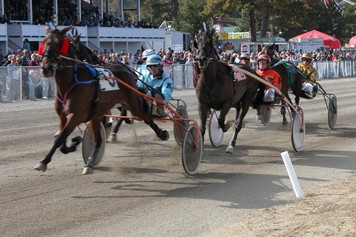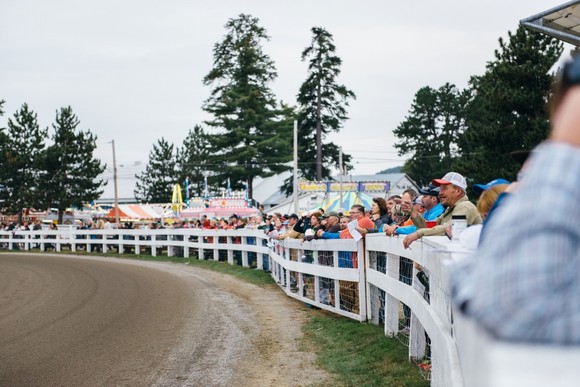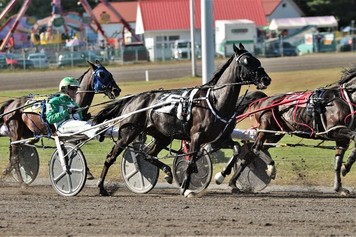Events
This year’s agricultural fair season is a celebration of a century and a half of horse-powered excitement. Harness racing is still a big draw for fair-goers and what most people don’t realize is that fairs helped evolve the sport from the country lane diversion it was in the 1800s to the million-dollar industry it is today.

Totting Parks to Fairgrounds
Back in the 1800s, before fairs and racing found each other, harness racing was the go-to spectator sport in rural Maine. Stephen Thompson, coordinator of the Lost Trotting Parks Heritage Center, estimates that 110 towns had at least one trotting park, usually a dirt 1/4- or 1/2-mile track carved out from someone’s woodlot, that hosted regular races year-round, weather permitting. He’s tracked the lost footprints of many of them using satellite imagery software. These home-grown tracks from Caribou to Kittery were training grounds for small-town drivers and provided welcome entertainment for local residents.
Agricultural fairs were also growing in popularity in the 1800s, when agricultural and horticultural societies were a driving force in every community and universities were highly focused on ag-based research and education. By the end of the century, almost every region of New England held an annual county fair where people could showcase their farm products, learn new methods, and celebrate the agrarian lifestyle.
Of course, at that time horses powered everything, and the faster, stronger, and sturdier your horse, the better. So, it’s not surprising that horses were attending fairs too, but mostly to compete in ways that put a shine on their agility, speed, and pulling power.
|

As the public’s appetite for harness racing grew and the industry developed, county fairs began to feature the sport and town leaders built tracks and grandstands, often in or near fairgrounds, to support it. Development of the Standardbred horse in New York in 1849 unofficially crowned harness racing a true American sport, and the legalization of pari-mutual betting in 1935 brought it over the finish line as a mainline recreational activity.
“Harness racing has been a form of thrills and excitement for over 200 years and has been center stage at many agricultural fairs for over 150 years,” said Mike Cushing, Maine Harness Horseman’s Association president. “It provides afternoon entertainment for fairgoers, often during the week, when there’s not as much activity to draw people to the fairgrounds. Fairs that partner with harness racing are also recipients of state stipends, which help provide additional funding.”
Including the sport at county fairs has paid off for the state in other ways too. According to a study by the Maine Center for Business and Economic Research at the University of Southern Maine, agricultural fairs generated more than half of the total annual racing wagers in 2016. Plus, tourists visiting Maine fairs and attending races generated an estimated $7.5 million in expenditures.
Across the U.S., more than 200 fairs in 22 states host harness racing events. This year, eight of Maine’s 25 agricultural fairs will feature racing, starting in Presque Isle in late June and finishing up at Fryeburg the first week of October. More than 50 races, plus sire stakes and invitationals, are scheduled.
Something for Everyone
Whether fairgoers head to Skowhegan or to Cumberland, harness racing adds an exciting dimension to the experience. “Fairs are a source of entertainment, whether you gamble or not. And harness racing is just part of the entertainment wheel,” said veteran Maine driver and owner Gary Mosher. He added that even people new to the sport find it interesting when they tune into it.
“Even if you just grab a bag of popcorn and sit in the grandstands for a while, maybe watch one, two, or three races, keep your ears open and learn,” he suggested. “Listen to what people are saying about the horses on the program. Watch the horses warming up. Which ones have their ears up? Does the horse’s coat look healthy and bright?”
Fans of all kinds get excited about the sport. “A racecar fan, a sports fan, a gambler, a stock player ̶ all can find something they can relate to in harness racing,” said Cushing. “People can study the race form, pick a favorite athlete (driver), place a bet on their selection, and cheer on their selection – just like deciding on a solid stock in the Wall Street Journal. But with a little luck, you can turn your investment into a profit in less than two minutes!”
But for many spectators, the sport’s appeal comes from experiencing the horses’ sheer beauty and visceral power in action and from watching two highly skilled athletes – human and equine – join forces for a prize-winning finish.
2019 Season Highlights
Whether you’re a new fan or a seasoned one, the 2019 fair circuit is not likely to disappoint. The season kicked off with live racing June 29 – July 2 at the Northern Maine Fair. The Presque Isle-based track dates back to the 1860s and is remembered as the venue where, in 1925, Single G beat John R. Braden in three straight heats with record times.
|
 Next up is the Topsham Fair August 6 ̶ 11, which is home to another one of the oldest tracks in the state. The half-mile track was built in 1864 by the Sagadahoc Agricultural and Horticultural Society under president Solon White. Racing happens at Topsham August 4 and 5, before the fair opens, and on the 6th, 7th, and 10th.
Maine’s first invitational of the fair season, the Walter H. Hight Memorial Pace on August 17th, plus a week’s worth of exciting racing take place at the Skowhegan State Fair August 11 – 17. The Hight family’s connection dates back to 1877 when Enock Hight of Norridgewock raced a horse named Ino, considered one of the finest horses in the county, at Skowhegan. Last year’s winner, Kenrick N, driven by Ron Cushing, finished with a time of 1:54.2. The Hight Pace is highly regarded and will draw Maine’s top drivers and pacers.
The Union Fair races regularly draw large crowds who watch from the track’s original grandstand built in the 1890s. The fair dates back to 1869, and, since 1960, showcases the Maine Wild Blueberry Festival. Harness racing made its debut in 1892. The Union Fair track was the first in the state (and possibly the nation) to dismantle the hub rail on the inside of the track for safety reasons. Today, every track in the U.S. has followed their lead. Races are set for August 18 and August 20-23.
This year’s Windsor Invitational is September 2, which is typically the biggest race day at the Windsor Fair and, by some counts, of the whole season. The Invitational tops off a week of daily racing starting on August 25 and draws top competitors from Maine and other states. Last year, Bet You, owned by Scott Dillon, trained by Joe Nelson and driven by Eddie Davis Jr., took first with a time of 1:53.3. The Windsor Fair dates back to 1888. Before the track was built, races were held on a public road starting at South Windsor Corner and finishing at the current fairground entrance.
Seven days of races kick off at the Farmington Fair September 15. Historical records show the Fair’s racetrack opened in 1867, and on the last day of the 1898 fair an unusual “ladies-only” race was held. 2019 marks the 179th year of the Farmington Fair.

Harness racing is also a daily event at the 2019 Cumberland Fair fairgrounds September 22 – 29. When the sport debuted at Cumberland in 1871, racing took place on Main Street. Today, opponents race on a clay track that was built in 1941. The fair wraps up September 28, but there’s an extra day of harness racing on the 29th.
Wrapping up the season is the Fryeburg Fair and the Mountain Skipper Invitational Pace, set for October 6. The Pace pays tribute to the legendary Standardbred Mountain Skipper, the famed New England horse who sired multiple New York sire stakes winners, was Pacer of the Year multiple times, and set records at Fryeburg in the ‘70s. Art of Illusion, driven by Kevin Switzer, Jr., took first at the 2014 Mountain Skipper Pace with a time of 1:55.2.
Fryeburg will draw the best racers in New England, with live racing October 1 – 6. Named Maine’s “Blue Ribbon Fair,” the fair encompasses 185 acres, is the state’s largest and 2nd largest in New England after the Big E. This year marks the 168th Fryeburg Fair; the main track and grandstand used today opened 125 years ago, in 1894.
All eight agricultural fairs and Maine’s two commercial tracks in Bangor and Scarborough will include sire stakes races in their 2019 programs, adding an extra dose of home-grown flavor. Maine’s sire stakes racing program was developed by the Maine Standardbred Breeders and Owners Association (MSBOA) in 1972 to promote the breeding and raising of horses in Maine, which is a $1.8 million industry statewide. Sire stakes races are categorized by age (2-year-olds and 3-year-olds) and gait. (For the 2019 Sire Stakes calendar, visit MSBOA’s site at: https://www.mesirestakes.com/.)
All in all, the 2019 fair harness racing season will feature 46 days of exciting races, drawing long-time fans as well as new ones to eight historic tracks around the state.
“Maine’s fairs are geographically diverse, and they enjoy a loyal following that’s usually handed down over generations,” said Henry Jennings, Executive Director of the Maine Harness Racing Commission. “This all adds up to a great opportunity to showcase harness racing to new generations of fans as they follow their parents to their local fair. We’ll see you at the fair!”
|
“Maine’s fairs are geographically diverse, and they enjoy a loyal following that’s usually handed down over generations,” said Henry Jennings, Executive Director of the Maine Harness Racing Commission. “This all adds up to a great opportunity to showcase harness racing to new generations of fans as they follow their parents to their local fair. We’ll see you at the fair!”
|
2019 Agricultural Fairs with Harness Racing
|
|
Fair
|
Fair Dates
|
Racing Dates
|
|
Northern Maine Fair
|
June 28 – July 3
|
July 29 – July 2
|
|
Topsham Fair
|
August 6 – 11
|
August 4, 5, 6, 7, 10
|
|
Skowhegan Fair
|
August 8 – 17
|
August 11 – 17
|
|
Union Fair
|
August 17 – 24
|
August 18, 20 – 23
|
|
Windsor Fair
|
August 25 – September 2
|
August 25 – September 2
|
|
Farmington Fair
|
September 15 – 21
|
September 15 – 21
|
|
Cumberland Fair
|
September 22 – 28
|
September 22 – 29
|
|
Fryeburg Fair
|
September 29 – October 6
|
October 1 – 4
|
Sources:
2019 Maine Sire Stakes Race Calendar, ME Harness.com, https://www.meharness.com/SireStakes/2019stakescalendar.shtml
Agricultural Fairs, Visit Maine website:
https://visitmaine.com/things-to-do/agricultural-attractions/agricultural-fairs
Devlin, Philip, R., “A Rich History of American Agricultural Fairs,” Durham, SC Patch, September 20, 2011, https://patch.com/connecticut/durham/a-rich-history-american-agricultural-fairs
Harness Racing Museum Hall of Fame website:
https://harnessmuseum.pastperfectonline.com/
Kanes, Candace, “Fair Season: Crops, Livestock and Entertainment,” Maine History Online, Maine Memory Network, no date, https://www.mainememory.net/sitebuilder/site/1420/page/2084/display
Maine Agricultural Fair Association website:
https://www.mainefairs.org/
Maine Center for Business and Economic Research, "The Economic Contribution of the Maine Harness Racing Industry,” 2017, Harness Racing Commission Documents. 12.
http://digitalmaine.com/hrc_docs/12
MEharness.com website
New England Harness Racing News, October 5, 1982, Vol. 11, No. 10, pg. 12.
Temple, Robert, The History of Harness Racing in New England, Xlibris Corporation, U.S., 2010.
Warner, Pete, “Hallowell Historian Unearths Golden Era of Maine Harness Racing,” Bangor Daily News, July 18, 2015. https://bangordailynews.com/2015/07/18/sports/harness-racing-sports/hallowell-historian-unearths-golden-era-of-maine-harness-racing/
Whitehouse, Randy, “Preserving Maine’s Horse Racing History,” Lewiston Sun Journal, March 18, 2012.
Photo credits:
In order of appearance:
Cumberland Fair, 2018. Photo by Lexy Chadborne; courtesy Maine Harness Racing Commission.
Fryeburg Fair, 2018. Photo by Rachel Andrews Damon; courtesy Maine Harness Racing Commission.
Fryeburg Fair, 2017. Photo by Cara Dolan; courtesy Maine Harness Racing Commission.
Cumberland Fair, 2018. Photo by Stephanie Gray; courtesy Maine Harness Racing Commission
|